![]()
![]()
![]()
Use LEFT and RIGHT arrow keys to navigate between flashcards;
Use UP and DOWN arrow keys to flip the card;
H to show hint;
A reads text to speech;
65 Cards in this Set
- Front
- Back

Commodus as Hercules Rome, c. 191 CE |
LUXURY -about a ruler who dedicated his life to frivolous persuits and luxury -adorned with references to this labours -portrait captures his vanity thru the grand pretensions of his costume and the classical idealization of his figure |
|
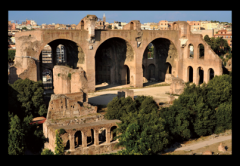
Basilica of Maxentius and Constantine, Rome 313 CE |
ADMINISTRATIVE -functioned as an administrative centre and provided a magnificent setting -strong support for the central groin vaults allowed an opening for window space
|
|
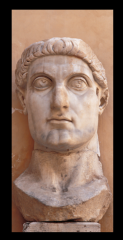
Constantine the Great, Rome, 325CE |
MONUMENTAL -monumental portrait -served as a stand in for the emperor and a powerful reminder of his imperial power -representation of his godlikeness |
|
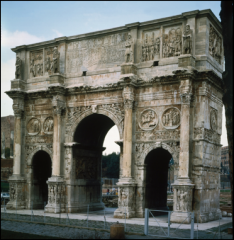
Arch of Constantine, Rome 315CE |
POWER -emphasis on authority and power rather than on individualized outward form -is far removed from the classicizing of illusionism of earlier imperial reliefs |
|
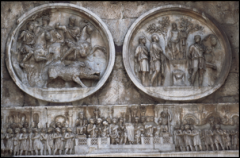
Arch of Constantine, Rome 315 CE |
DETAIL -depiction of Constantine's first public speech after defeating maxentius -recounts the story of his victory and proclaims his power and generosity -depicting important events with detail -2D hierarchal approach |
|
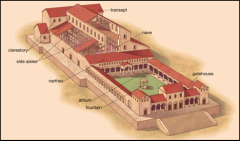
Reconstruction drawing and plan of Old Saint Peter’s Basilica, Rome, c. 320-327; atrium added in later 4th century
|
|
|
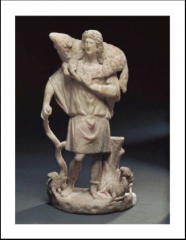
The Good Shepherd, Eastern Mediterranean, probably Anatolia, second half of the 3rd century
|
RELIGIOUS TOLERANCE -persecuted christians would have this as an allegorical representation of jesus -they wouldn't get in trouble if someone found this because it looks like a regular shepherd, but christians gave it meaning |
|
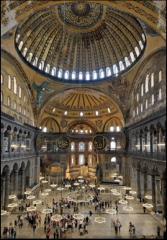
Church of Hagia Sophia 532-537 CE (minarets added after 1453), Istanbul, Turkey
|
PRETTY DOME -embodies both imperial power and christian glory -dominated by the hovering form of its gigantic dome -dome achieves a weightless effect thru the light reflecting gold mosaic that covers its surface, as well as the band of 40 windows around the base |
|
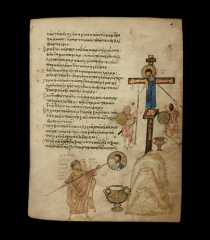
Manuscript page illuminated with Crucifixion and Iconoclasts from the Chludov Psalter. Mid-9th century
|
ICONOCLASM iconoclasm- prohibition and destruction of visual works of art and icons usually because they were considered inappropriate in religious contexts -made after the iconoclasm controversy, records harsh judgement of iconoclasts -tormenting christ by being soaked with vinegar sponge |
|
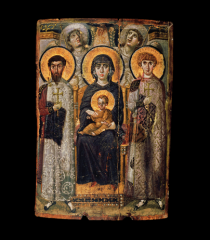
Virgin and Child with Saints and Angel.
Icon in the Monastery of St. Catherine, Mount Sinai, Egypt Second half of 6th century [encaustic on wood] |
ICON -a surviving icon (representations of sacred figures or events) -jesus on her lap suggests she has become his imperial throne -mary, jesus and angels were rendered detailed and lifelike -warriors are more stylized, tense faces, addresses viewers directly |
|
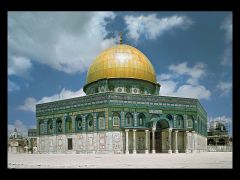
Exterior View of the Dome of the Rock. Jerusalem, Israel. Begun 691.
|
MOSAIC -decorated on the inside with a mosaic containing the earliest written form of the qur'an -first architectural manifestation of islams view of itself as completing and superseding the prophesies of judaism and christianity |
|
|
Page from the Quran (surah 2:286 and title for surah 3) from Syria, 9th century
|
calligraphy (the art of fine hand lettering) -written on vellum, fine parchment (animal skin). |
|
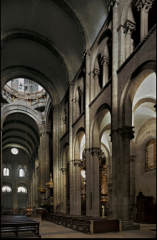
Cathedral of Saint James Santiago de Compostela, Galicia, Spain, c. 1078-1122
|
expansion of church to accommodate growing amounts of people |
|
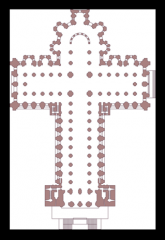
Cathedral of Saint James Santiago de Compostela, Galicia, Spain, c. 1078-1122
|
EXPANSION -large interior spaces were necessary to accommodate the crowds of pilgrims who went to church 4 shines - Romanesque builders increased the number of chapels -permitted pilgrims to move freely from chapel to chapel without disturbing church services |
|
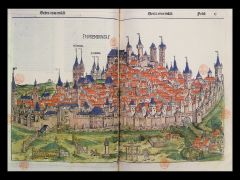
The City of Nuremberg, 1493, library Mazarine, Paris |
COLOUR PAPER -expansive cityscape by a bibliophile who could afford to have the woodcuts painted by hand to enhance the appearance of the pic |
|
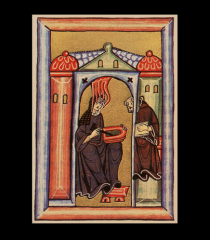
Hildegard and Volmar, from a facsimile of the frontispiece of the lost Liber Scivias of Hildegard of Bingen, Original manuscript (now lost), c. 1150-1175
|
THATS SO RAVEN VISIONS -one of her visions -shows hildegard receiving a flash of divine insight, represented by tongues of flame encircling her head -she wrote down mystical visions she had been experiencing |
|
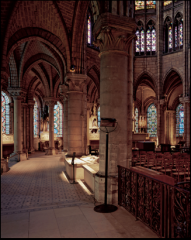
Abbey Church of Saint-Denis, Interior view of the choir France, 1140-1144
|
STAIN GLASS WINDOWS -first gothic building housed by tombs of french kings -pointed arches, ribbed groin vaults and external buttressing that relieved stress on walls -pLAN OF THE CHOIR: stain glass windows to emphasize space -contemplation of light seen as a means of illuminating the soul and uniting it with god |
|
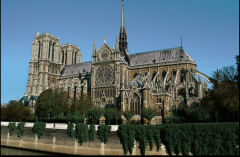
Cathedral of Notre-Dame Paris, France, Begun 1163
|
- a symbol of paris -rose windows -flying buttresses support the high vault of the choir |
|
|
Two page opening with The Kiss of Judas and The Annunciation, from the Hours of Jeanne dEvreux, Paris, France, c. 1325-1328
|
SPECIAL BOOKS/ GREYSCALE -private prayer books were popular -called the book of hours b/c they contained special prayers to be recited at special hours -book is in grisaille (paintings made only in shades of grey) |
|
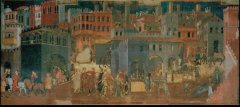
Ambrogio Lorenzetti. Effects of Good Government in the City Siena, Italy, 1338-1340
|
BUSTLING URBAN SCENE -portrayal of a vibrant urban scene filled with bustling activity of productive citizens - also shows the city from shifting viewpoints so we can see as much as possible -renders people larger in scale than the buildings to highlight their activity |
|
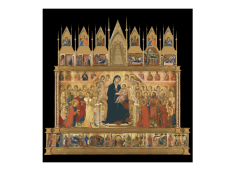
Maestà (majesty) Altarpiece Made for Siena Cathedral, Italy,
1311 |
LOTS OF WORK -assembled by many wood panels before painting -had to be painted on both sides because it could be seen from all directions when installed on the main alter -softened figure and linear grace and easy relationship btw figures and their settings |
|
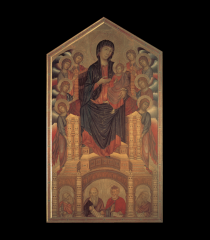
Cimabue.
Virgin and Child Enthroned Florence, Italy, c. 1280 |
-set precedent for monumental altarpieces -surrounded hierarchically scaled virg and child with angels and places a row of prophets beneath -captures divine radiance with lines of gold on drapery -throne is architectural frame work for composition |
|
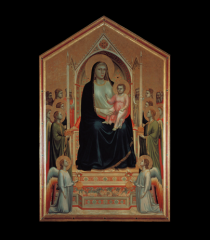
Giotto di Bondone. Virgin and Child Enthroned Florence, Italy, 1305-1310 |
PERFECTNESS -symmetrical composition -created the sense that these are fully 3D beings who's plainly draped, bulky bodies inhabit real space -revived art of good drawing and painting from live models that hadn't been done for over 200 yrs
|
|
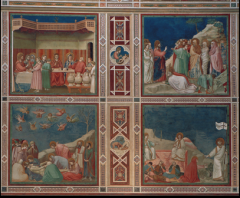
Giotto di Bondone, Scrovegni (Arena) Chapel Padua, Italy, 1305-1306
|
-chapel is simple and provides broad walls and boxlike space to showcase the paintings -artist's narrative skills are apparent in the 4 pictures -complex |
|
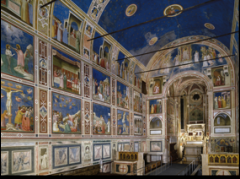
Giotto di Bondone, Scrovegni (Arena) Chapel Padua, Italy, 1305-1306
|
^ |
|
|
Leonardo da Vinci. Vitruvian Man Galleria dellAccademia, Venice, Italy, c. 1490
|
-ideal male figure that fits within both circle and square. -ideal body should be 8 heads high in proportion |
|
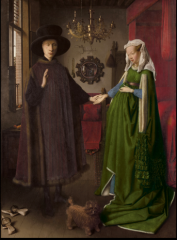
Jan van Eyck, Double Portrait of Giovanni Arnolfini and His Bride, 1434
|
-painting is full of mysteries = pregnant? wedding? financial deal? -wealthy couple due to luxurious objects around them -prayer beads imply religious couple. -dog symbolizes faithfulness b/w couple, also rare breed symbolizing wealth -mirror represents all seeing eye of god |
|
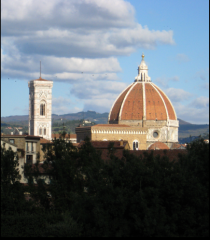
Filippo Brunelleschi, Dome of the Florence Cathedrall Florence, Italy , 1420-1436
|
-built up layer by layer, each dome reinforced the next one -self buttressed unit that required no external support |
|
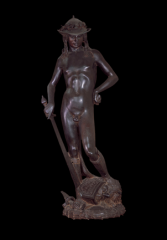
Donatello. David Florence, Italy, c. 1446-1460
|
-classical tradition of heroic nudity -pose, expression and underdeveloped body is an attempt to heighten the heroism of a child who takes on the adult responsibility of defeating and enemy warrior |
|
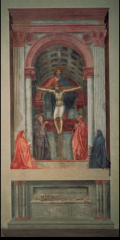
Masaccio, Trinity with the Virgin, St.John the Evangelist, and Donors Florence, Italy, c. 1425-1428
|
-linear perspective to give effect of looking into a barrel vaulted niche -figures organized in a measured progression into space |
|
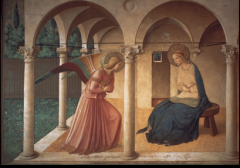
Fra Angelico, Annunciation Monastery of San Marco, Florence, Italy, c. 1438-1445
|
-natural light on their forms, casting a radiant glow over their face and hands -a sacred vision rendered in a contemporary setting -made to inspire mediation |
|
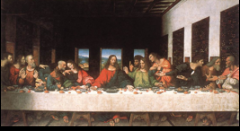
Leonardo da Vinci. Last Supper Monastery of Santa Maria delle Grazie, Milan, Italy, 1495-1498
|
-captures the moment where jesus tells his companions that one of them will betray him -they react individually presenting the study of human emotions -jesus in the centre shows importance -one point linear perspective, windows give natural light -artist modelled figures in rich chiaroscuro used to create gradual transition from highlight to shadow creating illusion of 3D form |
|
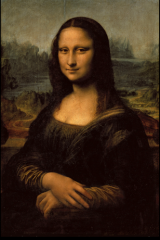
Leonardo da Vinci. Mona Lisa Painted in Florence, Italy, c. 1503-1506
|
-enigmatic expression = hides rather than reveals her thoughts and personality -embodies characteristics of high renaissance style -stability in the human form and structure |
|

Raphael, Madonna of the Goldfinch Florence, Italy, 1506
|
-monumental pyramid form of the 3 figures in the composition as well as the carefully modelled draperies reveals impact of work -clear even light contrasts with has sfumato (gives smokey effect) -goldfinch is a symbol of christ death on cross |
|
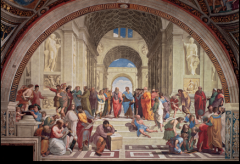
Raphael. Philosophy or The School of Athens Vatican, Rome, Italy, 1510-1511
|
-plato gestures towards heaven and aristotle towards ground, emphasizing main nature of each of their philosophies -calm dignity of figures -viewers look at scene thru illusionistic arch |
|
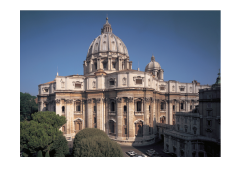
Michelangelo. Saint Peter’s Basilica View from the southwest Vatican, Rome, Italy, c. 1546-1564
|
|
|
|
Michelangelo. Pietà From Old Saint Peters, Vatican, Rome, c. 1500
|
-inconsistencies in scale and age are forgotten -virgin looks 2 young - youthfulness perhaps and physical manifestation of her inner virtue -was meant to be seen up close so u cud look at jesus beautiful ass face |
|

Michelangelo. David Florence, Italy, 1501-1504
|
-embodies antique ideal of athletic male nude -unlike donatello's david, this is not a triumpant depiction of a hero |
|
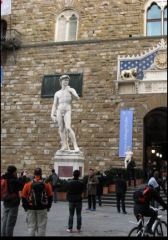
Michelangelo. DavidFlorence, Italy, 1501-1504
|
|
|
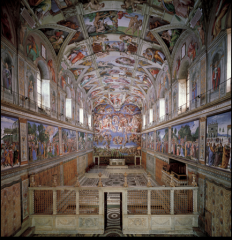
Michelangelo. Sistine Chapel [ceiling] Vatican, Rome, Italy, 1508-1512
|
-consists of illusionistic and architectural structure filled with individual figures and narrative scenes - |
|
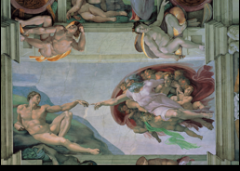
creation of adam
Rome, Italy, 1508-1512 |
|
|
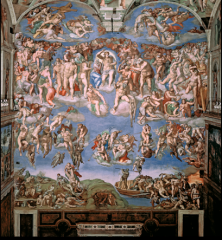
Michelangelo. Last Judgment. Sistine Chapel, Vatican, Rome, Italy, 1536-1541
|
-fresco-dominated by flesh tones and sky-created new standard of a concept that shows figures equalized in their nudity-second coming of christ and final judgment |
|

|
Shamans cup Southwest Alaska, Circa 1780-1810 |
|
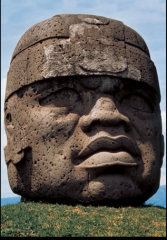
Colossal Head. Olmec culture San Lorenzo, Mexico, c. 1200-900 BCE
|
- series -monumental exposed works -resemble individual people. not generic -different faces -setting changes the context and perspective (better on grass) |
|
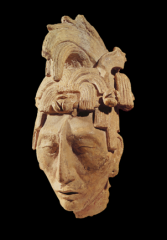
Portrait head of Pakal the Great From his tomb, Temple of the Inscriptions Maya culture, Palenque, Mexico, mid-7th century CE
|
-depicts ruler of corn god -hair recalls leaves of corn plants -embracing idea of plants -he embodies the core plants used for survival -elites/rulers were represented in sculpture over gods |
|
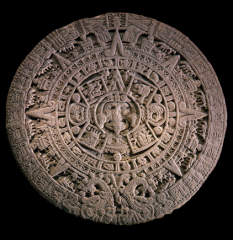
Aztec Calendar Stone Mexico, Aztec, c. 1500 CE
|
-highly complex and accurate calendar -more accurate than current day calendar -precise measurement of time and space |
|
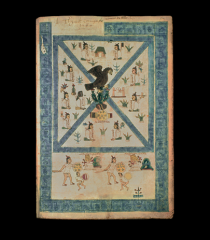
The Founding of Tenochtitlan, page from the Codex Mendoza. Mexico, Aztec, 1545 CE
|
-city represented in a pyramid like space -idealized representation of the city - pictorial decorative- people all together speaks to the community in their culture -bird and cactus represent the strength and core beliefs of their culture |
|

The Goddess Coatlicue Mexico, Aztec, c. 1500 CE |
-a decapitated godess -relating to significance of sacrificial death in their culture |
|
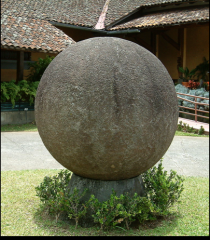
Stone sphere made by the Diquis culture Costa Rica, 700 to 1530 CE
|
-perfect sphere -most amazing things made by mankind -distinctive for perfection, density, number and size and original locations (contextual relevance- marshy lands) |
|
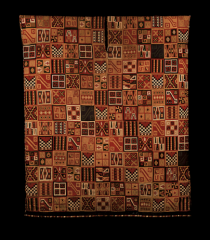
Tunic. Inca Peru, c. 1500 CE
|
-each square represents a mini tunic with a different pattern and meaning -series of patterns and mini history |
|

Wampum Belt, Wendat (Huron) Quebec, Canada, ca. 1612 |
-nemonic prompts for memory to retell stories -geometric line based patterns were primary visual language of traditional weaving -represents nationhood -documents, treaties, passed down stories |
|
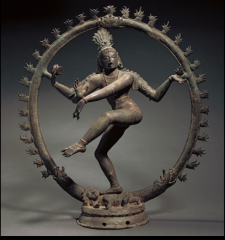
Shiva Nataraja (Shiva as Lord of the Dance). Chola dynasty South India, 11th century CE |
-embodies bhakti movement - active and exciting - flame represent destruction- belief in needing destruction 4 creation -generously displayed in full awareness of her benevolent powers = aware that we are aware of their awareness, joining powers |
|
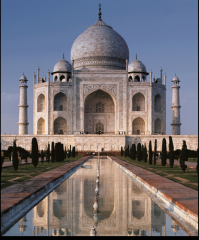
Taj Mahal. Mughal period Agra, India, 1631-1648
|
(compared to dome of rock) -not rectilinear in shape, go all around -central dome, basic structure -symbol of india -representation of paradise as mentioned in the qur'an = architecture and space used to create environment of paradise |
|
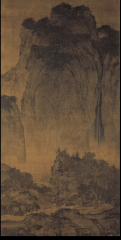
Fan Kuan. Travelers Among Mountains and Streams Northern Song dynasty, China, early 11th century
|
- painted of external essence of mountain-ness, not a reproduction of an actual scene -defined 4ground and background, ambiguous middle ground = idea of knowing the start and end but the journey between the two is unknown - not for us to know in this point of our life on this path |
|
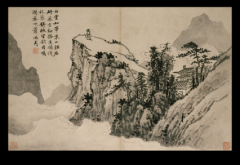
Shen Zhou. Poet on a Mountaintop. Ming Dynasty China, c. 1500
|
-shift towards different style -less colour and detail, very expressive brushwork -brushwork is straight forward and simple -poet experiences self reflective moment |
|
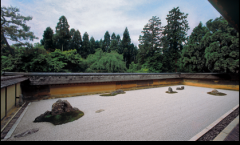
Rock garden, Ryoan-ji. Muromachi period Kyoto, Japan, c. 1480 Y |
-wabi sabi- quiet and natural aesthetic, appreciation of non refined -set in asymmetrical groups of 2,3,5 or 7 -never showing symmetry because that means balance -made it your responsibility to bring balance to the work. -point of asymmetry in this work is to encourage the individual to bring balance to the work |
|
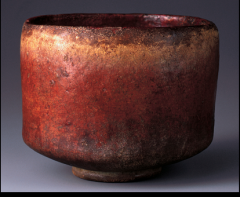
Raku ware (Chojiro) Teabowl, called Yugure ("Twilight”), Momoyama period Japan, late 16th century
|
-developed for use in tea ceremony, function is more important than looks -non traditionally beautiful -traditional Chinese vessels lived on until rayku embraced the aesthetic of beauty in simplicity and everyday life |
|
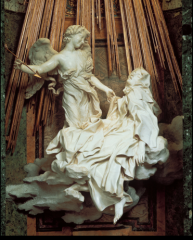
Gianlorenzo Bernini, Ecstasy of Saint Teresa of Ávila Church of Santa Maria della Vittoria, Rome, 1645-1652
|
-depiction of a vision where and angle pierced her repeatedly, transporting her into a state of ecstatic oneness -sexual af- orgasmic state, greater meaning tho (connecting with divine) -eroticism -theatrical interplay |
|
|
Gianlorenzo Bernini, Saint Peters Basilica and Square (piazza) Vatican, Rome, c. 1656-1657 |
|
|
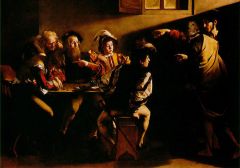
Caravaggio. The Calling of Saint Matthew Church of San Luigi dei Francesi, Rome, 1599-1600 |
- realism and dramatic light -so realistic that it was questioned and troubled people -harsh long light- intense bright and dark creating highly developed figures |
|
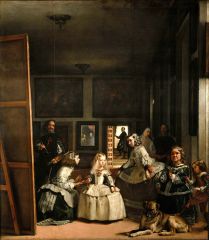
Diego Velázquez. Las Meninas (The Maids of Honor) Spain, 1656 |
-multiple portraits: royal portrait and also self portrait of artist |
|
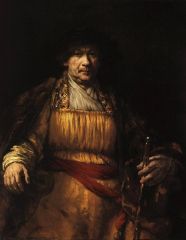
Rembrandt van Rijn. Self-Portrait Dutch Republic, 1658 |
-face and eyes are weary and introspective -dramatic light - dark to light to emphasize realism |
|
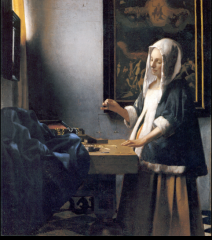
Jan Vermeer. Woman Holding a Balance Dutch Republic, c. 1664 |
-woman contemplating weight in hand= drawing attention to the act of weighing and judging -behind is painting of last judgment, highlighting image of god over her head- judging |
|
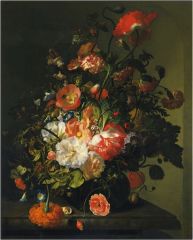
Rachel Ruysch. Flower Still Life Dutch Republic, After 1700 |
|
|

Jean-Honore Fragonard, The Swing, 1767 |
-excessive ornamentation & visual sensuous imagery and theme -frivolous sensuality - man looking up skirt -no larger meaning |

